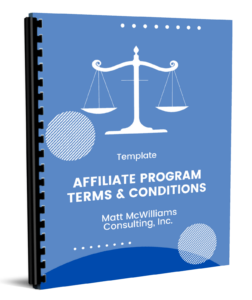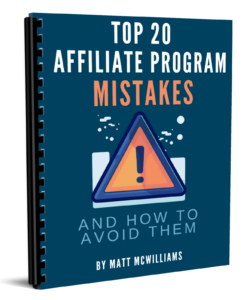Breaking bad news is never easy, especially when it involves your affiliates. But sooner or later, we all need to know how to deal with challenging situations in our affiliate program. In this episode, I’ll share how to master the delicate art of delivering less-than-ideal updates to your affiliate partners. Learn how to maintain trust, manage expectations, and turn challenging situations into opportunities for growth. This may not be the most fun episode I’ve ever done, but it’s a must-listen!
Click Here for The Written Transcript of This Episode
Make sure that your affiliate program has a solid agreement (AKA Terms & Conditions). To make things simple, grab my template here!
Links Mentioned in this Episode
Top 20 Affiliate Program Mistakes
TRAINING – How to 10X Your Sales WITHOUT Spending All Day on Social Media or Expensive Paid Ads
TEXT ME: 260-217-4619
Don’t Miss An Episode – Subscribe Below
Previous Episodes of The Affiliate Guy
How to Triple Your Webinar Sales with Affiliates
How to Identify and Stop Affiliate Fraud
How to Solve the 15 Biggest Challenges for All Affiliate Programs
What the Latest Research Says About Affiliate Bonus Packages
How to Give Your Affiliates What They Need to Succeed
How to Build an Army of Loyal Affiliates
How to Communicate Bad News to Your Affiliates
Breaking Bad news is never easy, especially when it involves your affiliates. But sooner or later, something is going to go wrong, something’s going to break, and we all need to know how to deal with these challenging situations in our affiliate program. So in this episode, I’m going to share how to master the delicate art of delivering less than ideal updates to your affiliates.
You will learn how to maintain trust, how to manage expectations, and how to turn challenging situations into opportunities for growth. Now this may not be the most fun episode I’ve ever done, but it is a must listen. So what happens when things go wrong?
It’s gonna happen. As I said in the intro, things will happen, things will break, something’s gonna go wrong. You’re gonna have issues in your affiliate program, and we’ll talk about some of the different types of things that can go wrong. But what do we do when those things go wrong?
How do we react? What are the steps that we need to take to not only mitigate the bad news, but actually take advantage of it? I want this episode to offer up an opportunity to you that bad news, problems, mistakes, things breaking, all those kinds of things can actually be good news for your affiliate program. They can cause your affiliate program to grow.
And that sounds crazy, but that’s how we operate as humans. There’s a term called post traumatic growth, right? All these things we would never wish upon anyone. We would never wish that somebody has to go through those
life experiences, but they’re always better for it. Or they’re usually better for it if they use it as an opportunity. Well, it’s to a much lesser degree and much lesser severity here. It’s the same thing.
These are things we don’t want to happen. But there one of these things is going to happen to you. I’m going to list a few examples here of things that could go wrong. One of these is going to happen to you in the next three to five years.
I guarantee it. They’re going to happen maybe multiples, maybe one thing is going to happen twice, I don’t know. Something is going to happen and you’re going to need to know how to react.
You’re going to need to know how to make it less bad, but also make it a positive. So what are examples of some bad news that you would have to communicate? You know, the first one, the most obvious one for affiliate programs is the tracking is down.
This is something that will happen to every affiliate program roughly every five to ten years. It has happened to me multiple times with multiple programs, whether I was on a network or an in house program. The mechanism that controlled the tracking, not the website, but
that’s another one. You know, unexpected downtime on your website, but the tracking is down and this affects everyone. This affects all of your affiliates, and it affects you. You know, you’re not able to pull up reports or anything like that.
A lot of times if you’re on a network and the whole network goes down, that affects everyone. So let’s talk about the next one, that the website downtime, specifically when it’s unexpected, it is not bad news. If every few years you reach out to your affiliates to say, hey, our website is undergoing regular maintenance on Tuesday night between 02:00 a.
m. and 06:00 a. m. eastern time, that is not bad news.
Need help activating your affiliates? Use my proven email templates for getting inactive affiliates in the game and making sales! Get them here!
That’s a completely different thing. I’ve talked about how to communicate just in general with your affiliates. That’s something where you communicate in advance. You remind them, you remind them and you remind them that, hey, if, you know, keep your links up.
But I probably wouldn’t send out a promo email that night. Don’t send out a promo email at 09:00 that night. Don’t plan on sending one first thing the next morning just in case does turn into 09:00 a. m.
that would kind of be bad news. Like, hey, the downtime is longer than we thought, but if you plan those in advance, they don’t have to be a problem at all. So unexpected downtime, your website crashes, your database goes down and orders aren’t processing. Something like that.
Credit card processor doesn’t work. All those types of things. Something happened to impact conversions or the average order size.
A part of your website went down, or you can’t take orders from outside the United States, or a funnel piece broke a split test, had a negative impact, those types of things. Product is out of stock and it wasn’t anticipated. I’ll talk about that example later. That’s happened to me.
Product recall never had that one happen. Payment delays, that’s happened. You know, I had to pay late reducing commissions due to increased cost or other factors where this wasn’t anticipated. And all of those have happened to me except the product recall.
I’ve had to deal with every single one of those at least one time. I’ve probably had to deal with tracking being down a dozen to 15 times. I’ve had to deal with conversions or average order size, things like that a couple dozen times.
I’ve had a product go out of stock a couple of times. I’ve never had a product recall. I’ve had payment delays probably five, six times over the last two decades.
I’ve had to reduce commissions once. And I’ve had unexpected website downtime. Haven’t had it in almost a decade. Knock on wood.
Right? But I mean, I had it pretty frequently in the late two thousands, 2005 to 2010. We probably had it happen eight to ten times. We put a heavy load, the company that I started back then, we put a heavy, heavy load in our server and we never had enough firepower.
And we had these ebbs and flows where we would have spikes in traffic and it wasn’t bot traffic, but it was like good traffic and our site would just go down for like 15 minutes. And it was always frustrating. So all of these things have happened and it sucks, but how you deal with it, and it’s not like some great life lesson, right? You know, life sucks and things go wrong, but how you deal with it, by gosh, no.
But that is what matters. In fact, as I mentioned earlier, issues like this, if they’re dealt with properly, could actually be a huge plus for your program, bouncing back from what seems like a devastating problem. It can strengthen your relationships with your affiliates. It can even make them trust you more.
So how do we do that? How do we deal with these situations? So when the proverbial stuff hits the fan, what’s the first thing that we do? Well, the first thing you got to do is stay calm, especially when it’s something that is out of your control and it’s wreaking havoc like
downtime. I’m assuming you’re not also your sysadmin for your server, right. The network tracking goes down. When that happens, you gotta stay calm.
Like these are out of your control. Things like products running out, you usually at least have a little lead time to prepare. You don’t run out of product. You don’t go from having a full shelves, we got enough product to last months to, oh, we’re out of product.
That doesn’t happen in a matter of seconds. Downtime and tracking issues can happen immediately. You can have tracking 1 second. You can have a website at 12:42 a.
m. or pm and at 1243, you don’t have a website, you don’t have tracking, but stay calm. Take a deep breath.
Okay? Just take a deep breath. If you have time, if it’s looking like your product is gonna run out or that there’s going to be something, again, usually you have a heads up. Product recalls typically don’t happen in a matter of seconds
either. Never had that happen. But they don’t usually happen overnight. Usually there is some sort of heads up like, okay, we’re three
days away from might, we might have a product recall or payments being delayed. You don’t go from, payments are being made today, typically to, oh, they’re not going to be made for a while. Although actually I have had one instance where that happened. So again, stay calm, take some deep breaths.
You don’t have a lot of time because number two is be fast. And it seems contradictory, but it’s not like I’m not saying take 500 deep breaths and go for an hour long walk. Again, if you have to communicate bad news and you’ve got weeks of lead time, like, okay, you know that the product is going to run out in three days.
Taking a half hour walk is going to be fine, but otherwise, you got to be fast. The faster you acknowledge the issues, the better they must learn. Meaning the affiliates, your affiliates, must learn about issues from you, not from other sources.
So if you’ve got an affiliate Facebook group, and I recommend you do because it’s good for so many things, one of the problems is if they find out about it from other people, that’s a problem. Now I get it. If at 1242, your website’s up and you go to the bathroom and the website goes down right away, and at 1251, you come back from a bathroom. From the bathroom or from lunch, and your website’s down and you find out about it on Facebook from.
That’s understandable. But again, don’t just ignore it. Don’t just reply or start a new thread and acknowledge it. Right.
Get my #1 affiliate recruiting email (the one I’ve personally used to recruit thousands of affiliates in dozens of niches). Grab your copy here!
So this initial contact should be short. It should cover three main things. Number one, acknowledgement of the problem, just be clear about it. Here is the problem.
I’m going to walk you through an email in a second. Here’s the problem. Number two, we’re working on it. Number three, I’ll keep you updated.
So acknowledge the problem. State that you’re working on it. State that you’ll keep them updated. You don’t need a ten point plan.
You don’t need a link to email. Just let them know you’re working on it. That’s it. It’s three sentences.
Three sentences. That’s it. So number one, stay calm, take a deep breath. Number two, be fast.
Number three, don’t sugarcoat. Don’t do the whole feedback sandwich thing where it’s like, you know, good news, bad news. Good news is the promo is going great.
Bad news is our server’s down. Good news is once it’s back up, the promo will be great again. No, just cut to the chase. Skip the good news part.
There is no good news right now. The server is down, tracking is down, the product is about to be out or whatever. So be honest and direct.
That’s the key here. Be honest and direct. I’m going to share some emails that I’ve sent in the past. All right?
Now I’m going to read these to you. If you want, just send me a text at 260-217-4619 260-217-4619 I’m happy to send these to you. It’s not like an automated thing.
So just text me, say, hey, can you send me the bad news emails or something like that? All right, so here’s a couple of examples. The first one is just one that we used when tracking went down and the subject line was tracking down for Shutterfly. Again, subject line, not bad news, not heads up or make sure you
read this or, hey, John, no tracking down for Shutterfly if I don’t read the email, here’s what I know. The tracking is down for Shutterfly. That’s what we want. I just said, hey, you know, first name, quick, heads up.
The affiliate tracking for Shutterfly is down. It has been for the roughly the past 15 minutes since 335 eastern and gives them a specific time. We’re doing everything we can to get it back up and working properly and I’ll update you as frequently as possible. I’ve also created an update thread here and that link to a Twitter thread, this was like 2013.
I linked to a Twitter thread where I announced it and then I updated it every, you know, ten minutes with just a quick, like, no word yet, haven’t heard back. Just talk to the network. They set an eta of an hour. Boom.
So I update there. If you have any questions, feel free to reach out. So again, quick heads up. Affiliate tracking is down.
I give him the time, 15 minutes, 03:35 p. m. we’re doing everything we can to get it back up. I’ll update you.
Here’s where to find updates. If you have any questions, feel free to reach out. That’s the email. That’s it.
It covers those three things, right? Acknowledgement of the problem. We’re working on it. I’ll keep you updated.
That was probably one of the longest ones I’ve sent for a tracking issue, and it was five sentences long. All right, another one. Product is about to run out. Okay.
This was an unexpected product that we were going to run out of. The subject line was out of stock. Name of product. I’m not going to name this company here.
Right. I just said, hey, first name. Just want to let you know so you’ll notice this one’s a longer one. Why?
Because this is not like there’s a problem right now. And we’re working on it. Bye. You know, just want to let you know that we’re just about to run out of name of product.
This is a bit of a surprise to us as a shipment from China is significantly delayed and we’re not sure when it will be back in stock. As of now, it looks like we will run out in approximately two to three days, but definitely by this upcoming weekend. This was sent on a Monday. If you planned any promotions for name of product, I recommend pulling them until at least April 17 to be safe.
I think this was sent around April 1 ish, but I’ll keep you updated and let you know if anything changes. But there is almost no chance right now that we’ll be back in stock by April 3. But name of company is already working with another vendor to
get a rush shipment in by April 13. So the 17th gives us a little wiggle room. If you have any questions, don’t hesitate to reach out. And then I sent out another email a couple of days later.
Hey, we are definitely within 24 hours of running out. I would pull all of your links, et cetera, et cetera. At that point, I didn’t know for sure. And then I sent one, like three or four days later.
We will definitely have shipment on April 12, and they will be sellable on the 13th. So there we go for payment delay. Again, direct and to the point. Subject line commissions late by two to three days.
You know exactly what you’re getting out of this. The cool thing is, if you don’t really care, you know, you’re somebody. You’re earning $30 a month, and it’s not really like you’re active. You’re just kind of making.
Who cares? You don’t even need to read it. You know, there’s two thirds of the affiliate programs I’m in. I don’t care if the payments are late by three days.
I don’t even know when they’re due half the time. So it’s not a big deal. Now there’s a few where like, we got a $24,812 payment coming. I kind of would like that on time.
That’d be nice. But most of the time I don’t really care. So subject line commission is late by two to three days. Hey, first name, just want to let you know in advance.
And it looks like affiliate commissions will be late by two to three days for October. Again, this is one where we found out last second it was an urgent thing. This was not like we knew five days in advance, but it is a little bit longer an email because it’s not one of those emails where it’s like we already have the solution.
So it’s a company name, just had, you know, name of their payment processor account shut down and it’s doing everything they can to get it back up. Trust me, this sucks. And I hate that we’re going to be late. Since we don’t know when it will be back up, we’re going to use an alternative payment platform, which we are setting up right now.
Again, acknowledge the problem. We’re working on the issue sometime tomorrow, hopefully first thing in the morning, I’ll send a link to set up your payment information there. It then takes two business days to verify your information and two more to pay you, which puts us right at two days late.
If for some reason everything is fixed with the other payment processor, we’ll issue those payments as soon as possible. If you have any questions, let me know. Notice I didn’t fill it with a bunch of gobbledygook about valuing them and we value your partnership and blah, blah, blah, blah, right? No, I cut to the chase.
I apologize if it makes sense. I tell them we’re working on it and they will update them. That’s it. Now I tell them I’m going to update them.
Well, number four, remember, number one, stay calm, take a deep breath. Number two, be fast. Number three, don’t sugarcoat.
Number four, you actually need to update them frequently, but not too frequently because that gets annoying. So the best way to do this for things like downtime, tracking issues, all those things, create a blog post. Now if your site’s down, that might not be doable because your site’s
down. That’s why I actually usually host our affiliate blogs on a separate domain on a separate server. Usually our affiliate blog doesn’t get enough traffic, a few hundred visits a day if we’re lucky.
So I don’t even mind hosting that. Usually I host that on like the $20 a month. WordPress hosting, that’s one of the reasons is like that way if the server goes down, I’ve still got the blog server up.
So you put up a blog post and then you update that post and it just becomes like a running update, right. With the most frequent thing. Newest, uh, you could do a Twitter, you know, x thread, you could do a Facebook post, you could do it in the affiliate Facebook group, whatever it is. Just start a thread, update with comments, with any relevant
updates. And then once it’s updated, then you put like final, hey, this is fixed. Problem solve, yada yada. For big issues, you know, every two to 3 hours is a good mix
between frequency and annoying. Even if it’s just to say no new updates, the team is working on it. If there are big updates like the product is out of stock, then update them. So in that example before, I think I said, you know, we’ll have the product around the 13th, so plan on the 17th.
But I just found out that it’s moved up to the 12th. I told them it’s moved up to the 12th. That’s worth a post and maybe even an email, which is what I did. So number four, update them frequently, but not too frequently.
Number five, when it’s fixed, communicate that quickly. So this is something you have to prepare for in advance. Okay. You know that it’s going to be fixed.
You have time. If it’s the product out of stock, things like that. You got a lot of time, you got days probably. But even if it’s the sites down, tracking is down, you know it’s going to be fixed.
So work on the email communicating that it’s fixed while it’s being fixed. And if that’s not practical, then just send out a quick it’s fixed and I’ll follow up later. So I’m going to give you two emails that I’ve sent.
The first one is when I ran a big affiliate promo with a huge team and I didn’t have to be involved in fixing the problem. So I had time to craft a message to send in advance. It was a product out of stock and now it’s back in stock. The second email is actually one where I was literally helping to reboot the server.
We were bootstrapping this and I was the CTO, the CSO chief sales officer, and I ran customer service and I ran the affiliate program. I did a ton and I was also basically the head of SEO. I mean, we were a small company. We had like ten of us.
We were running almost a million dollar a month affiliate program. And I was doing all these things. So I was involved in all this. So it’s a different vibe, right?
All right, so the first one, I’ve got time. I wrote this email. The subject line was, name of product back in stock. Hey, first name, it’s official.
Name of product is back in stock. Yeah, baby. I can’t do a british accent, apparently. I don’t know what that was.
I’m just going to keep that in. I should probably just insert. I think it’s a copyright violation. I should insert Austin Powers saying, yeah, baby there.
Anyway, and I had an image of Austin Powers saying, yeah, baby. You know, I said, I know it was a rough eleven days. And I’m super grateful to our whole team for getting us back on track here. To make up for this problem, we’re running a huge promo on name of
product. Not only will customers save 20%, but we’re also paying you some huge bonuses. I then go on to explain the promotion, the bonuses, etcetera. I explained how we’re able to do that because the shipment from China will be there in five days.
It’s actually been cleared through customs. So now we’re expecting all this extra product. Plus we have a local distributor. So I explain, you may be thinking like, hey, you just ran out of this product, now you’re going to run a promo on it and offer us huge commissions.
You’re crazy. No, I explained why that we’re able to do that. I give them their link, some new creative. We refreshed it during the out of stock period.
So that’s the thing. Hey, here’s this nice thing we’re doing. We have brand new creative because we ran out of product. So we had time to update the creatives, created some new
leaderboards, and it was a huge hit. Huge hit. This ended up being massive. We sold more of that product.
I’ve got the numbers here. We sold more of that product in the second half of April of 2014 than we did in the entire first quarter of 2014. And it was not a seasonal product. It’s not like, well, it’s cause summer.
No, it was not a seasonal product. We sold more product in two weeks than we sold in 13 weeks before this happened. That’s how you can turn these into a positive. So the second one, again, this is when we’re back to normal, right?
I didn’t have time. I didn’t have time to write a message while I was helping to reboot servers and figure out what was going on. We had been down for about an hour and a half or so, and I was busy that whole time. So I’m like, as soon as it was fixed, I’ve sat down and wrote the email and it just said, subject line, we’re back up.
If I had to do all over again, I probably would have put back online or something, or servers back up or something. But again, I was trying to be fast. Said, hey, first name, real quick, we’re back up and running. Total downtime was less than 90 minutes and we found the issue in the back end.
I’ll share more details later and we’ll make sure you’re compensated for the downtime. For now, we’re going to keep an eye on things and probably take a quick nap. Smiley face. Thanks for your patience on this.
Again, straight to the point, we’re back up and running. I don’t have time to get into the problem because that would be too long and I don’t, I don’t need to explain it and take ten minutes to write this and that’s ten minutes longer. You think we’re down, but I shared exactly what was wrong. Less than 90 minutes and then we’re going to fix it.
That’s what we put in that message. So, number six, remember, number one, we got to stay calm. Number two, we got to be fast. Number three, do not sugarcoat it.
If you are ready to take your business to the next level and start an affiliate program, start with my free report, Your First 100 Affiliates. This report takes nearly two decades of experience, trial and error, and lessons learned about finding top affiliates in nearly every conceivable niche and puts them all into one report. Grab your copy here!
Number four, update them frequently. Number five, when it’s fixed, communicate that quickly. And then, number six, in the end, follow up with a debrief after you send the email saying things are fixed. Want to follow up again with another email that’s got more details.
So on that example where I said, you know, we’re back up, hey, boom, boom, boom, quickly, we’re back up and running. I would send up a follow up email, depends on the time of day. Maybe later that day, first thing the next morning, hey, as you remember, we were down.
Remember earlier I said less than 90 minutes. I want to find out the exact amount of time. We were down for 83 minutes. We were down for 83 minutes yesterday, so I know that cost some of you some money.
So we looked at the numbers. We still could see traffic coming in. There are no conversions. And basically, we’re going to take your normal conversion rate.
And this is me not explaining here, but explaining to you. And let’s say the day before, you sent 100 clicks and converted ten. That’s a 10% conversion. And during that 83 minutes of downtime, you sent ten clicks.
We’re going to pay you for a conversion you would normally have made dollar 20. We’re going to just give you dollar 20 to make up for this. A lot of companies don’t do that. I do.
It just makes sense. It’s the right thing to do, and it makes them love you again. We want to use this as a positive. So we explain how we’re going to make it up to them.
Not just that, we’re going to. We explain it in detail, and then I’ll say something like, I’m going to send one more email where I outline your exact numbers, blah, blah, blah. So this is a little bit longer email with details. Right.
Sometimes they want to know the journey, too. Like, how’d you solve the problem and how are you addressing it going forward? Those types of things. And then, as I mentioned just now.
So, number six, follow up with a debrief. Number seven, make it up to them. Make it up to them. Pay those commissions for lost sales.
We did the promo for the out of stock stuff. We knew far enough in advance that we didn’t need to make up for it, per se, but I wanted to do something to make up for it. You know, they didn’t lose anything.
We give them plenty of heads up, but afterwards, when we were back up and running, like, hey, let’s do something to make this up to you. Let’s run this out of stock sale. If its tracking is down, you pay them for the lost commissions.
If tracking is down and you have no concept of how much was lost, then you kind of got to make it up. Well, your average daily commissions earned over the past three weeks is $500. So we were down for one 10th of the day.
So were going to pay you $50, something like that. And you make it up, it will come back tenfold over the next year or two. So there you have it. How to communicate bad news to your affiliates.
Number one, stay calm. Number two, be fast. Number three, don’t sugarcoat it. I’ve shared some examples, use those as guides.
Like just get to the point. Like man, I just cannot say it five sentences at a max on this initial email, unless, again, unless it is a longer one where you’ve got days in advance. Number four, keep them updated frequently, but not too frequently.
Number five, communicate any kind of a fix as quickly as possible. Update the blog post, update the thread, update the group, update them via email, et cetera. And number six, make sure you follow up with the debrief.
And of course, 7th, make it up to them, fix it, make it right. So there you have it. That is how you communicate bad news to your affiliates. I hope you never have to do it, but you know what?
You’re going to, you’re going to have to do it. So make sure if you haven’t yet, I mentioned earlier, if you never texted me, shoot me a text. I’m happy to send you these emails.
Like I said earlier, shoot me a text at 260-217-4619 that’s my favorite way to communicate. I just love communicating with people via text and it’s real time and more personal than, you know, sending me an email. So text me anytime. I’ve got links in the show, notes to everything we talked about as well.
And lastly, make sure if you haven’t yet hit subscribe so you do not miss the next episode. We’ll be talking about how affiliate managers spend their day. Like if you just want to see what’s a day in the life of an affiliate manager, like, it’s not as exciting as you might think it is.
That’s a terrible sales way to sell this episode. No, it’s good. You’re going to like it. So you want to know how we spend our days?
Go check it out. Go check out this episode. So make sure you hit subscribe so you don’t miss it. I’ll see you then.
Questions?
Text me anytime at (260) 217-4619.
Or…check out some of my free reports to help you get on the right track:
 |
 |
 |
 |
 |
 |
 |
 |
 |












